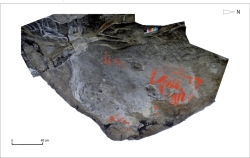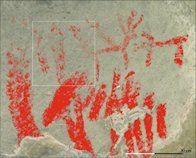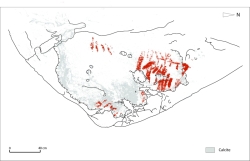

Figure 12a: Zoom onto figurative elements, including the possible anthropomorph in the top-left corner (Photo: L. Damelet; enhancement: C. Defrasne)
Our recording and assessment of the paintings initially employed photogrammetry and augmentation of digital images using D-Stretch (Harman 2005), along with the enhancement tools available within Adobe Photoshop (Brady and Gunn 2012; Mudge et al. 2012; Mark and Billo 2006; Domingo et al. 2013). We then supplemented these media with the Artec white-light scan. The combination of these methods has allowed us to clearly define and study with precision the range of motifs across the entire panel. Some of these painted elements were almost invisible on site, and on non-enhanced images (Figure 2 and white-light scan).
Despite several phases of occupation, attested to by the excavated archaeological material from the Abri Faravel, there might be just a single phase of painting. Other Alpine rock art sites bear witness to several phases of engraving and/or painting, one example being the Roche des Poignards or Les Oullas in the Ubaye Valley (Alpes-de-Haute-Provence), some 50km to the south-east of Faravel (Arcà 2004c; Mocci and Walsh 2007; Defrasne 2014) where we have at least four phases of 'artistic' activity.


As mentioned in the introduction, the paintings at Faravel include animal figures and groups of parallel lines. We interpret the animal figures as a deer facing a dog. Both animals are very schematic. From a stylistic point of view, the radiating antlers of the deer are of interest since this will allow us to make comparisons with rock paintings known elsewhere. A straight line, which we propose is a projectile (an arrow or a spear), is painted in the back of the deer, evoking a hunting scene. At first sight, there is no human figure within this 'hunting scene'. However, we do wonder if the anchor-shaped image at the left of the deer (framed on Figure 12a) might be a very schematic anthropomorphic figure. Some parts of these paintings are clearly less well conserved, and therefore unequivocal identification is difficult. Nevertheless, the symmetry of this figure might be an argument for such an interpretation. Moreover, the width and the curved shape of the top of the right segment do not support the notion that this element represents a second projectile. Such anchor-shaped figures are known elsewhere, particularly at Bessans (Savoie) (Nelh 1976) or at the Eissartènes (Le Val, Var) (Hameau 2009).

As well as the animal motifs at Faravel, the other, in fact more extensive, component of this set of paintings is the linear motifs (Figure 12 and Figure 13). These relatively broad parallel lines in two groups could have been painted with a thick brush. As many of the analogues for our motifs come from engravings (discussed later), we should remember that the act of painting is far quicker than engraving. Moreover, painted motifs will usually be less permanent. We should consider these variations in the investment of time by the 'artists', and possible associated notions of permanency and durability, in the interpretation of such images. As the scan from Faravel demonstrates, the greatest effort in this panel was the possible preparation of the surface. At the Eissartènes shelter (the Var, Provence, France), similar motifs, including a series of lines accompanied by animals (interpreted as deer), also appear to have been painted onto a prepared surface – in this instance, the preparation being the application of a 'priming' layer of diluted pigment (Hameau 2009, 208). At Faravel, the central ceiling surface was probably chosen as it is of lighter colour than the surrounding 'natural' rock surface, with the possibility that pecking enhanced this zone - the tint of this rock surface (a light grey-brown) would have rendered the paintings less visible (see the Artec scan for the most realistic representation of the colours).
Scanning Electron Microscopy undertaken by the Centre for Research and Restoration (Musées de France) revealed that the tan pigment at Faravel comprises red clay composed of iron oxide. In situ XRF spectrometry has been undertaken, and two micro-samples have been taken, and refined laboratory analyses are underway (by Emilie Chalmin EDYTEM, Université de Savoie-Mont Blanc). The pigment layer is very thin, rendering full characterisation difficult. Although such analyses are rare across the Alps, we do know that this type of pigment is common in rock paintings in south-east France. Here, different pigment compositions have been identified, including pure iron oxides (hematite), minerals rich in alumina (bauxite), or even cinnabar (mercury sulphide), which was used on stelae in Provence . Across the wider region, most pigments employed in prehistoric paintings comprise varying proportions of ochre/hematite. As the composition of pigments is not always dictated by what is available locally, some consider the possibility that pigment (composition) was a cultural choice, designed to articulate identity (Hameau 2009). Making choices at the different stages in the production of, and engagement with, the motifs is one theme considered next.